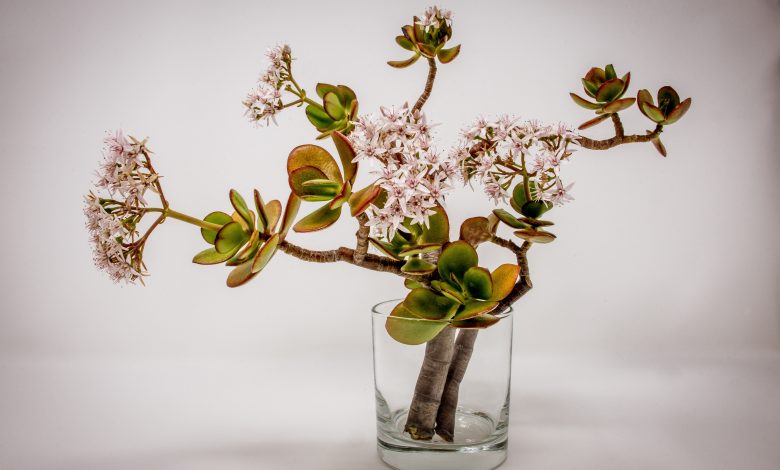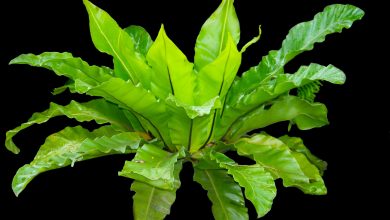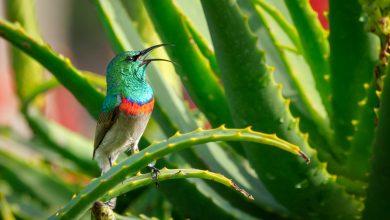Types of Jade Plants and Care Guide

The jade plant is a variety of succulent that is popularly used as an indoor decoration. As with most succulents, the jade plant is easy to care for because it needs very little attention to survive. Jades can grow in a variety of sizes, such as a small houseplant, a larger shrub, or an ornamental bonsai tree.
New varieties of jade plants are constantly being introduced as hybrid strains are created and propagated. It would be nearly impossible to collect every type of jade plant, as there are over 1,400 different species. As a succulent, jade plants are both uniquely attractive and easy to care for. Below we’ll go over a general care guide for jade plants and highlight some of the more interesting varieties of this distinctive vegetation.
How to Care for Jade Plants
Jade plants require very little watering, and most can be grown in a small pot on a windowsill that receives a reasonable amount of natural light.
Sunlight
Some succulents prefer just as much time in the shade as they do the sun. However, jade plants typically grow best in full sun. Try to put your jade plant in an area that gets at least four hours of sunlight per day. If you have a south-facing window in your house, that would be an ideal location for a jade plant. Typically, the more sun your jade plant receives, the larger it will grow.
Water
Succulent plants hold water in their thick, fleshy leaves, and jade plants are no different. Ensuring that your jade plant is in a pot that has strong drainage is essential. Clay pots work especially well for jade plants because they help to dry the soil by absorbing moisture. The main point to remember when it comes to caring for your jade plant is to avoid overwatering. Only water the plant when you see that the soil has completely dried out.
Your watering schedule will be different during the winter months. During the summer, you may need to water the plant once a week, but during the winter, the frequency could go down to once every three weeks. If you overwater your plant in the winter, you may notice the leaves start drooping downwards, which is a sign that the plant is dying.
Soil
Pick out a potting soil that is specifically meant for succulent plants. These types of soils will have strong drainage characteristics, which are essential for a happy and healthy jade plant. The soil should be slightly acidic, near 6.0 pH.
Fertilizer
Don’t be shy about using fertilizer on your jade plants during growing season. On younger plants, opt for a fertilizer that is low in nitrogen. For mature plants, use a balanced fertilizer. The frequency to add fertilizer can be as much as once a week at the beginning of growing season.
Temperature
Jade plants are not cold-tolerant, which is why they’re often best kept inside the house. Your jade plant will grow best at room temperature, typically between 65 to 75 degrees Fahrenheit.
Toxicity
While some jade plants are edible, many others can be toxic, especially to kids and pets. Keep your jade plant out of reach. Touching certain species can cause a burning or itching sensation on the skin, and eating part of the plant can lead to vomiting.
Pests
Mealybugs are the main pest that can cause issues with jade plants. If you notice a cotton-like substance on the stems of the plants, that is the sign of a mealybug’s secretion. These pests feed off the sap of the plant and eventually can create an infection in your plant. To prevent these bugs from finding their way into your plant, clean it with rubbing alcohol every now and then as a deterrent.
Propagation
Propagation is a common practice with succulent plants because the leaves are particularly adept at creating roots. With jade plants, you are looking to remove a branch, rather than just one of the leaves, as is common with other succulent varieties. Any healthy branch on your plant that is at least three to four inches long will be an option for propagation.
Using a sharp knife, cut the branch and let it dry out for a week. It seems counterintuitive, but the branch needs to completely dry out in order to grow again. If you notice that the branch is still moist after one week, wait an additional week before replanting.
Types of Jade Plants
The true jade plant is known as the crassula ovata. It is less commonly referred to as the money plant, the lucky plant, and the friendship plant. Crassula means thick, referring to the plant’s thick, fleshy leaves. And ovata means egg-shaped, referring to the oval shapes of the leaves.

Blue Bird Jade
Scientific name: Crassula blue bird
The blue bird jade is set apart from most other varieties by its lime green leaves. A common feature the blue bird jade shares with many other jade plants is a red outline that highlights the edge of its leaves. This plant will grow as tall as 20 inches but can be reduced to a smaller size depending on the size of its pot.
How to Care for Blue Bird Jade
The blue bird jade is easy to grow but is generally a slow-growing plant. As with all succulents, don’t let it sit in water. You can grow this plant both indoors and outdoors, as it can survive in temperatures as low as 25 degrees Fahrenheit.

Ripple Jade
Scientific name: Crassula Arborescens Undulatifolia
Also known as the “curly jade,” this plant is one of over 200 varieties of Crassulas. The ripple jade is perfect for succulent arrangements, as its thin leaves can easily fill smaller spaces. A fully mature ripple jade can grow as tall as four feet. In the right conditions, this plant can grow white flowers during the spring season. It can also develop a red color around its edges when it’s “happily stressed.”
How to Care for Ripple Jade
The ripple jade prefers full sun and can be grown indoors or outdoors. It can also survive in temperatures as low as 20 degrees Fahrenheit. Follow the same watering guidelines as you would for most succulent plants.

Botany Bay
Scientific name: Crassula ovata botany bay
One of the more recent jade plants to arrive on the scene is the botany bay variety of Crassula, which was introduced in 2011. It can grow as tall as three feet high over a five-year period with quality conditions. In late fall into early winter, it can flower with pink and white flowers. And like other jade varieties, it can develop a red blush under slightly stressful conditions.
How to Care for Botany Bay
The botany bay should be kept in medium to smaller-sized containers to reduce how far it can stretch out if it doesn’t live in an ideal condition for light.

Baby Jade
Scientific name: Crassula ovata minima
Also known as the miniature jade, this plant is a dwarf succulent, which can grow as much as 30 inches tall and 20 inches wide. The miniature part of the baby jade refers mostly to its smaller than average leaves, which are green with red edges. When it blossoms, the baby jade features small coral-colored flowers.
How to Care for Baby Jade
This plant will grow most effectively in full sun, but you can get away with partial sunlight. The baby jade prefers soil with a neutral pH. As always, the soil should have strong drainage characteristics.

Yellow Elephant Food
Scientific name: Portulacaria afra aurea
The yellow elephant food is a slow grower but works well in gardens where it can spread out and provide ground cover. As the name would suggest, elephants commonly eat this plant in its native country of South Africa.
How to Care for Yellow Elephant’s Food
Yellow elephant’s food is a forgiving grower. It is drought-tolerant and does not need a lot of watering. It can grow in most any soil type, but avoid soil with too much clay, as the plant will rot.

Rainbow Bush
Scientific name: Portulacaria afra variegata
The rainbow bush is a versatile stemmed succulent that is easy to grow. It features leaves that are a soft, creamy green color and is highlighted by its deep red-colored stems, sometimes bordering on purple. This plant also features purple flowers. If planted outdoors, the rainbow bush will thrive, covering ground and developing into a shrub that can grow as much as four feet tall.
How to Care for Rainbow Bush
When you water this plant, make sure that the soil is completely soaked. But do not water very frequently. While the rainbow bush will thrive outdoors, it can also be grown inside. Make sure that your pot will drain well and the plant is getting plenty of sunlight.

Hummel’s Sunset
Scientific name: Crassula ovata sunset
Named after plant hybridizer Ed Hummel, the sunset variety of the Crassula ovata is native to Mozambique and South Africa, where it commonly grows on rocky slopes. This plant is now commonly seen in southern California landscapes.
How to Care for Hummel’s Sunset
The Crassula ovata sunset is a particularly strong grower. It can thrive both indoors and outdoors and can survive in low light. This plant is recommended for beginner growers due to how forgiving it can be when growing. When not stressed by sunlight, its color can revert back to green.



